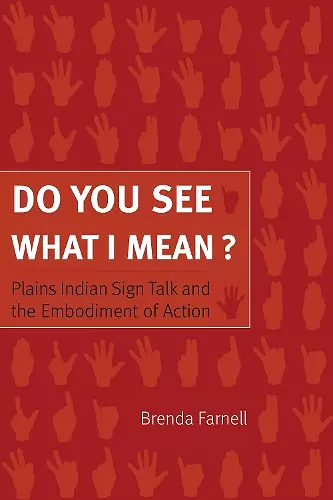Do You See What I Mean?
Plains Indian Sign Talk and the Embodiment of Action
Format:Paperback
Publisher:University of Nebraska Press
Published:1st Jun '09
Currently unavailable, and unfortunately no date known when it will be back

Study of Plains Indian Sign Talk (PST) and how it is still a component of the Assiniboine storytelling tradition
Plains Indian Sign Talk (PST), a complex system of hand signs, once served as the lingua franca among many Native American tribes of the Great Plains. Although some researchers thought it had disappeared following the widespread adoption of English, Brenda Farnell discovered that PST is still an integral component of the storytelling tradition in contemporary Assiniboine (Nakota) culture.Plains Indian Sign Talk (PST), a complex system of hand signs, once served as the lingua franca among many Native American tribes of the Great Plains, who spoke very different languages. Although some researchers thought it had disappeared following the establishment of reservations and the widespread adoption of English, Brenda Farnell discovered that PST is still an integral component of the storytelling tradition in contemporary Assiniboine (Nakota) culture.
Farnell’s research challenges the dominant European American view of language as a matter of words only. In Nakota language practices, she asserts, words and gestures are equal partners in the creation of meaning. Drawing on Nakota narratives videotaped during field research at the Fort Belknap reservation in northern Montana, she uses the movement script Labanotation to create texts of the movement content of these performances.
The first and only ethnographic study of contemporary uses of PST, Do You See What I Mean? draws on important developments in the study of language and culture to provide an action-centered analysis of spoken and gestural discourse. It offers a theoretical approach to language and the body that transcends the current “intellectualist” versus “phenomenological” impasse in social and linguistic theory.
“What is struggling to emerge is a theoretical framework in which the way that the different modalities of communication are articulated with one another can be understood. This book should be read by all those with an interest in the development of such a framework.”—Journal of the Royal Anthropological Institute
“A major contribution to Native American studies, to cultural anthropology more generally, to linguistic anthropology, and to semiotics. . . . In one and the same book, Brenda Farnell reveals the power and precision of gesture in oral performance, makes major advances in the understanding of the storytelling process in general, and teaches us more about the world of Native Americans than we have learned in many a moon.”—James H. McNulty
ISBN: 9780803222823
Dimensions: unknown
Weight: 522g
400 pages